Analyzing Business Operations: UK Organizations and Economic Impact
VerifiedAdded on 2023/06/10
|9
|1767
|452
Report
AI Summary
This report provides a comprehensive overview of business operations in the United Kingdom, examining various organizational types in the private and public sectors, including private limited companies, public limited companies, sole traders, partnerships, franchises, and non-profit organizations. It explains the different structures within businesses and the reasons for their variations, focusing on factors like ownership, market share, and scope for expansion. The report also identifies Tesco as a case study, describing how the local, national, and global economic environment impacts the company, with considerations for Brexit, global recession, and international trade. Furthermore, it emphasizes the importance of customer service for business success, highlighting the need for excellent service quality, timely delivery, and customer feedback. The report also addresses a scenario involving a local Chamber of Commerce providing advisory services to local businesses, stressing the significance of customer profiling and market segmentation. This analysis is supported by a range of academic references, providing a well-rounded perspective on the key aspects of business operations.
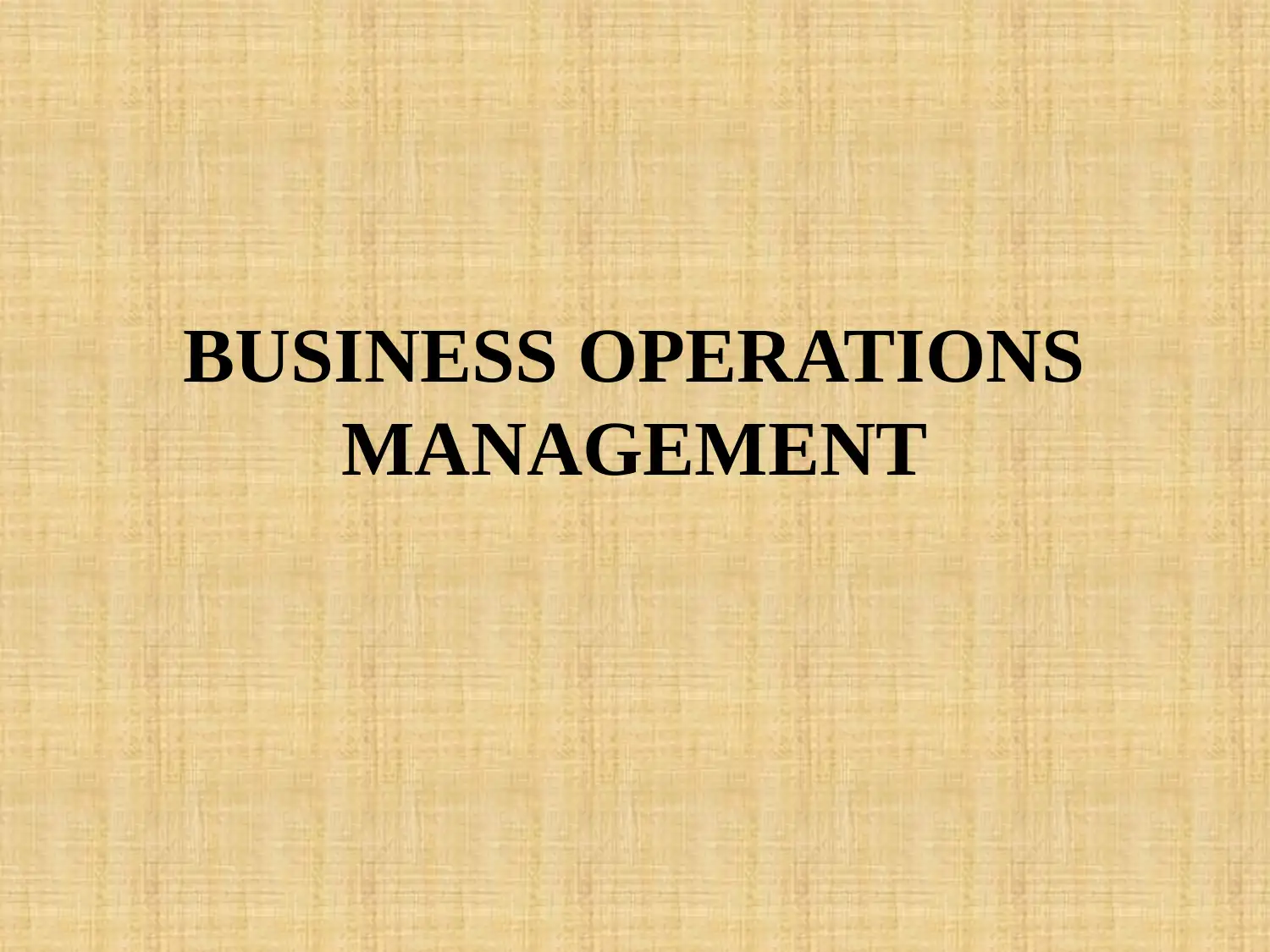
BUSINESS OPERATIONS
MANAGEMENT
MANAGEMENT
Paraphrase This Document
Need a fresh take? Get an instant paraphrase of this document with our AI Paraphraser
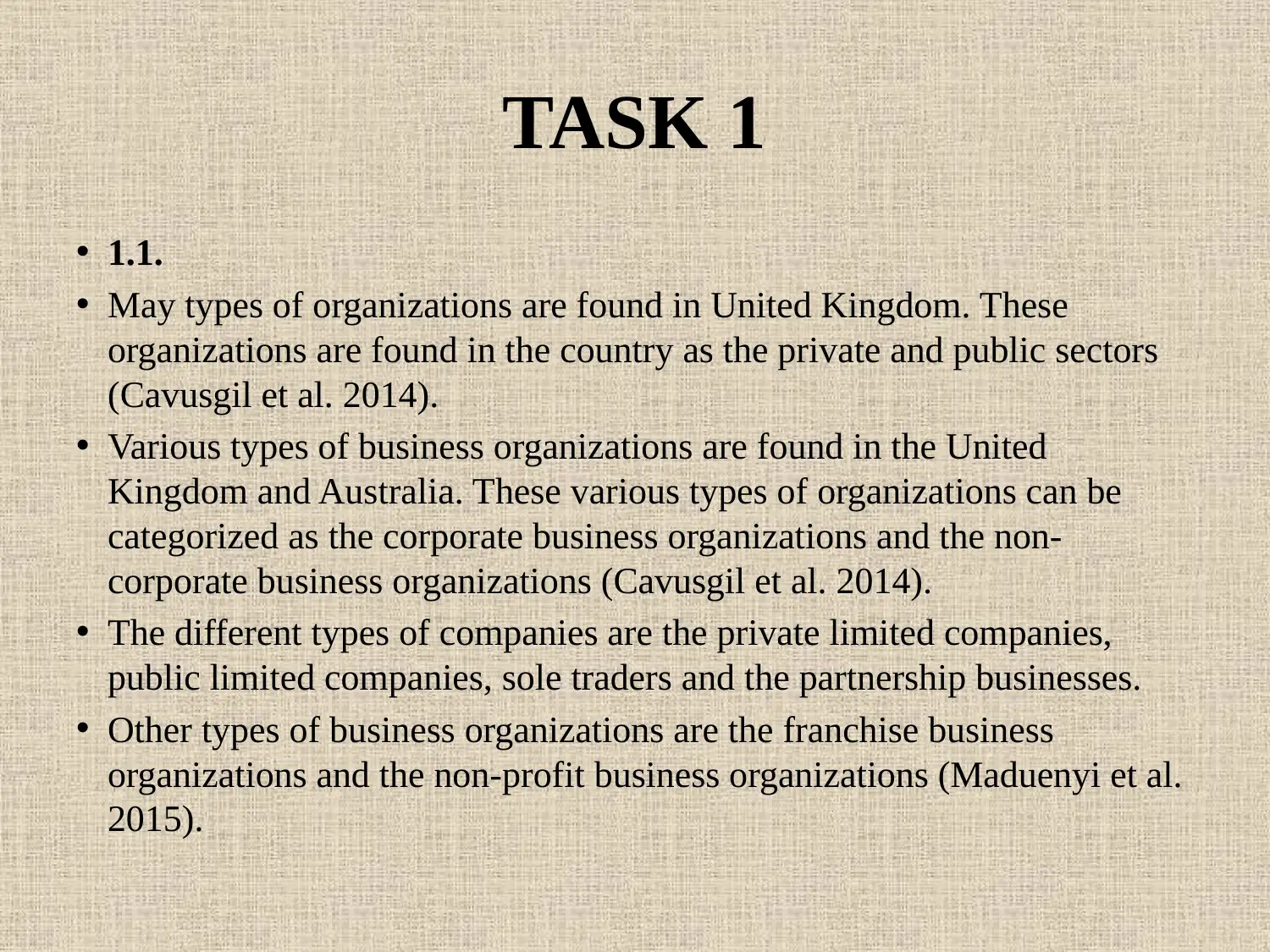
TASK 1
• 1.1.
• May types of organizations are found in United Kingdom. These
organizations are found in the country as the private and public sectors
(Cavusgil et al. 2014).
• Various types of business organizations are found in the United
Kingdom and Australia. These various types of organizations can be
categorized as the corporate business organizations and the non-
corporate business organizations (Cavusgil et al. 2014).
• The different types of companies are the private limited companies,
public limited companies, sole traders and the partnership businesses.
• Other types of business organizations are the franchise business
organizations and the non-profit business organizations (Maduenyi et al.
2015).
• 1.1.
• May types of organizations are found in United Kingdom. These
organizations are found in the country as the private and public sectors
(Cavusgil et al. 2014).
• Various types of business organizations are found in the United
Kingdom and Australia. These various types of organizations can be
categorized as the corporate business organizations and the non-
corporate business organizations (Cavusgil et al. 2014).
• The different types of companies are the private limited companies,
public limited companies, sole traders and the partnership businesses.
• Other types of business organizations are the franchise business
organizations and the non-profit business organizations (Maduenyi et al.
2015).
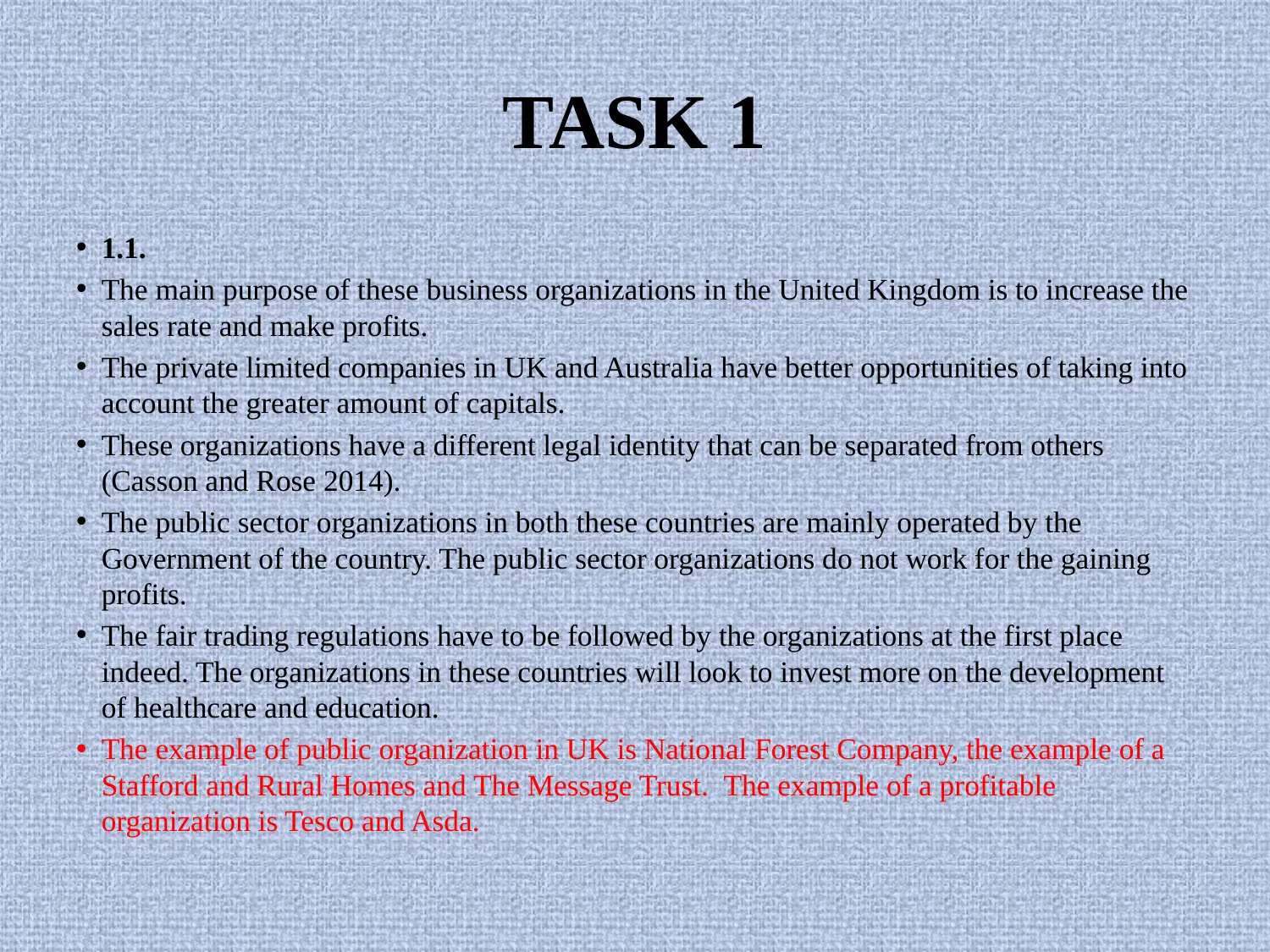
TASK 1
• 1.1.
• The main purpose of these business organizations in the United Kingdom is to increase the
sales rate and make profits.
• The private limited companies in UK and Australia have better opportunities of taking into
account the greater amount of capitals.
• These organizations have a different legal identity that can be separated from others
(Casson and Rose 2014).
• The public sector organizations in both these countries are mainly operated by the
Government of the country. The public sector organizations do not work for the gaining
profits.
• The fair trading regulations have to be followed by the organizations at the first place
indeed. The organizations in these countries will look to invest more on the development
of healthcare and education.
• The example of public organization in UK is National Forest Company, the example of a
Stafford and Rural Homes and The Message Trust. The example of a profitable
organization is Tesco and Asda.
• 1.1.
• The main purpose of these business organizations in the United Kingdom is to increase the
sales rate and make profits.
• The private limited companies in UK and Australia have better opportunities of taking into
account the greater amount of capitals.
• These organizations have a different legal identity that can be separated from others
(Casson and Rose 2014).
• The public sector organizations in both these countries are mainly operated by the
Government of the country. The public sector organizations do not work for the gaining
profits.
• The fair trading regulations have to be followed by the organizations at the first place
indeed. The organizations in these countries will look to invest more on the development
of healthcare and education.
• The example of public organization in UK is National Forest Company, the example of a
Stafford and Rural Homes and The Message Trust. The example of a profitable
organization is Tesco and Asda.
⊘ This is a preview!⊘
Do you want full access?
Subscribe today to unlock all pages.

Trusted by 1+ million students worldwide
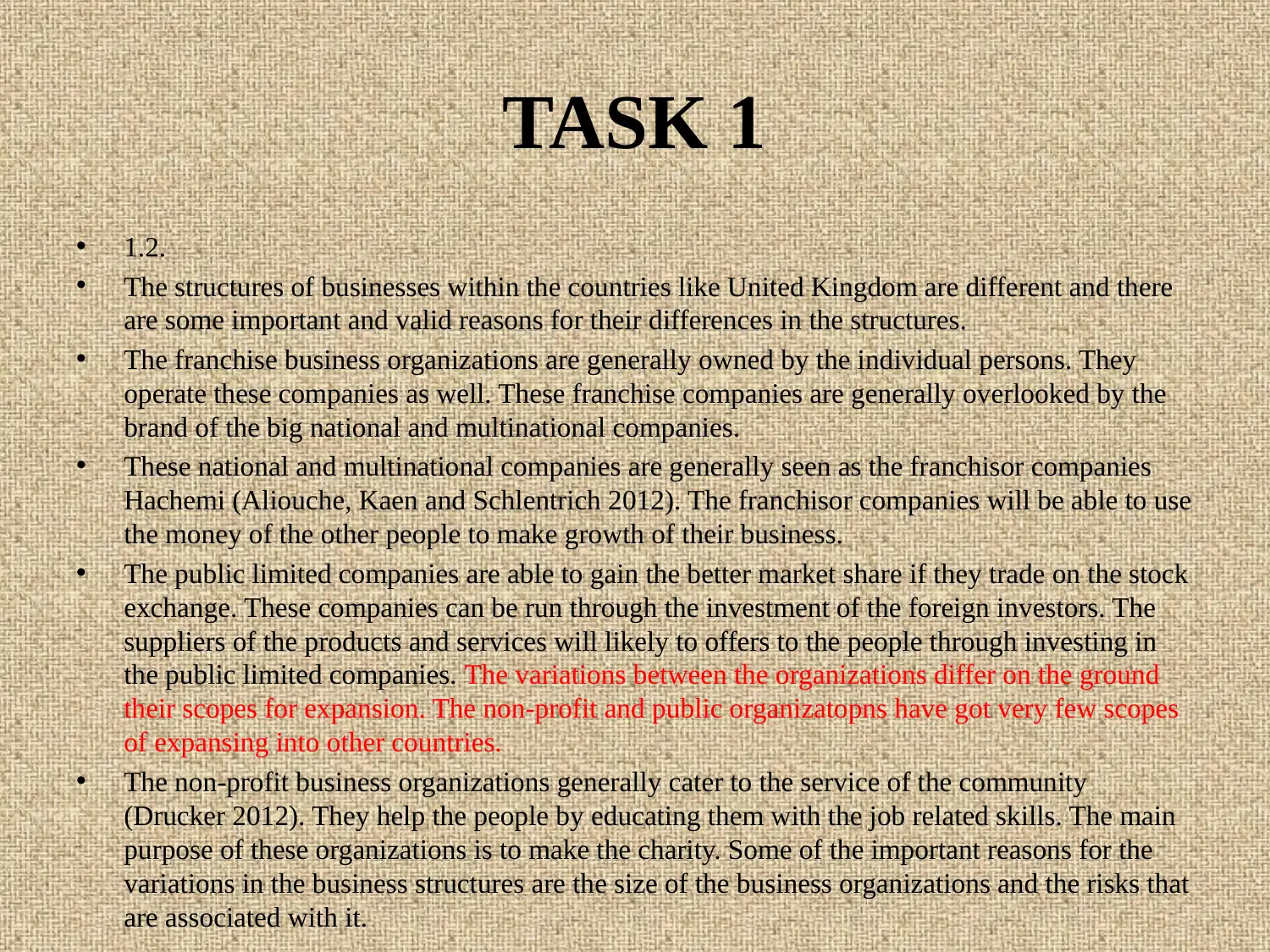
TASK 1
• 1.2.
• The structures of businesses within the countries like United Kingdom are different and there
are some important and valid reasons for their differences in the structures.
• The franchise business organizations are generally owned by the individual persons. They
operate these companies as well. These franchise companies are generally overlooked by the
brand of the big national and multinational companies.
• These national and multinational companies are generally seen as the franchisor companies
Hachemi (Aliouche, Kaen and Schlentrich 2012). The franchisor companies will be able to use
the money of the other people to make growth of their business.
• The public limited companies are able to gain the better market share if they trade on the stock
exchange. These companies can be run through the investment of the foreign investors. The
suppliers of the products and services will likely to offers to the people through investing in
the public limited companies. The variations between the organizations differ on the ground
their scopes for expansion. The non-profit and public organizatopns have got very few scopes
of expansing into other countries.
• The non-profit business organizations generally cater to the service of the community
(Drucker 2012). They help the people by educating them with the job related skills. The main
purpose of these organizations is to make the charity. Some of the important reasons for the
variations in the business structures are the size of the business organizations and the risks that
are associated with it.
• 1.2.
• The structures of businesses within the countries like United Kingdom are different and there
are some important and valid reasons for their differences in the structures.
• The franchise business organizations are generally owned by the individual persons. They
operate these companies as well. These franchise companies are generally overlooked by the
brand of the big national and multinational companies.
• These national and multinational companies are generally seen as the franchisor companies
Hachemi (Aliouche, Kaen and Schlentrich 2012). The franchisor companies will be able to use
the money of the other people to make growth of their business.
• The public limited companies are able to gain the better market share if they trade on the stock
exchange. These companies can be run through the investment of the foreign investors. The
suppliers of the products and services will likely to offers to the people through investing in
the public limited companies. The variations between the organizations differ on the ground
their scopes for expansion. The non-profit and public organizatopns have got very few scopes
of expansing into other countries.
• The non-profit business organizations generally cater to the service of the community
(Drucker 2012). They help the people by educating them with the job related skills. The main
purpose of these organizations is to make the charity. Some of the important reasons for the
variations in the business structures are the size of the business organizations and the risks that
are associated with it.
Paraphrase This Document
Need a fresh take? Get an instant paraphrase of this document with our AI Paraphraser
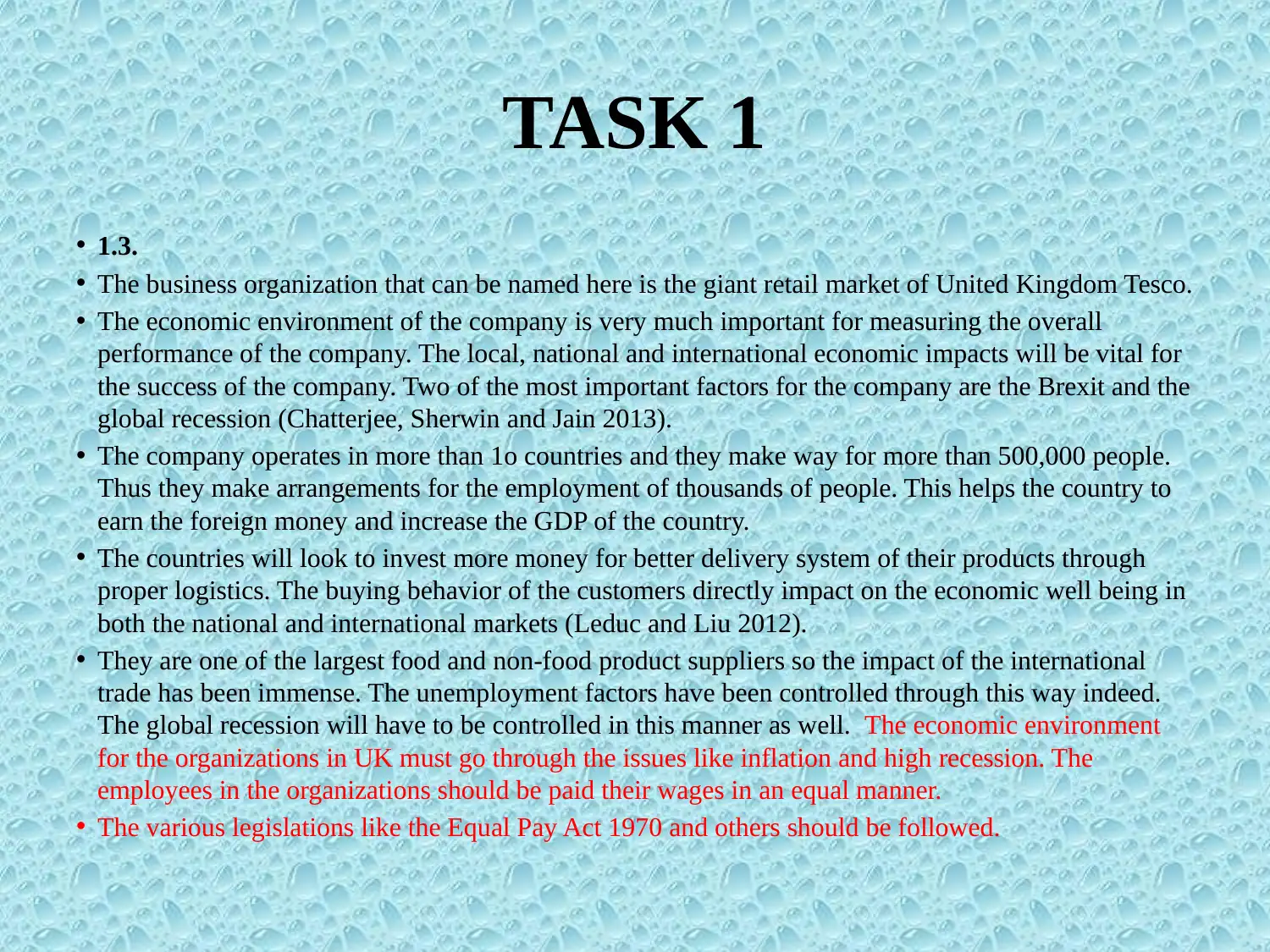
TASK 1
• 1.3.
• The business organization that can be named here is the giant retail market of United Kingdom Tesco.
• The economic environment of the company is very much important for measuring the overall
performance of the company. The local, national and international economic impacts will be vital for
the success of the company. Two of the most important factors for the company are the Brexit and the
global recession (Chatterjee, Sherwin and Jain 2013).
• The company operates in more than 1o countries and they make way for more than 500,000 people.
Thus they make arrangements for the employment of thousands of people. This helps the country to
earn the foreign money and increase the GDP of the country.
• The countries will look to invest more money for better delivery system of their products through
proper logistics. The buying behavior of the customers directly impact on the economic well being in
both the national and international markets (Leduc and Liu 2012).
• They are one of the largest food and non-food product suppliers so the impact of the international
trade has been immense. The unemployment factors have been controlled through this way indeed.
The global recession will have to be controlled in this manner as well. The economic environment
for the organizations in UK must go through the issues like inflation and high recession. The
employees in the organizations should be paid their wages in an equal manner.
• The various legislations like the Equal Pay Act 1970 and others should be followed.
• 1.3.
• The business organization that can be named here is the giant retail market of United Kingdom Tesco.
• The economic environment of the company is very much important for measuring the overall
performance of the company. The local, national and international economic impacts will be vital for
the success of the company. Two of the most important factors for the company are the Brexit and the
global recession (Chatterjee, Sherwin and Jain 2013).
• The company operates in more than 1o countries and they make way for more than 500,000 people.
Thus they make arrangements for the employment of thousands of people. This helps the country to
earn the foreign money and increase the GDP of the country.
• The countries will look to invest more money for better delivery system of their products through
proper logistics. The buying behavior of the customers directly impact on the economic well being in
both the national and international markets (Leduc and Liu 2012).
• They are one of the largest food and non-food product suppliers so the impact of the international
trade has been immense. The unemployment factors have been controlled through this way indeed.
The global recession will have to be controlled in this manner as well. The economic environment
for the organizations in UK must go through the issues like inflation and high recession. The
employees in the organizations should be paid their wages in an equal manner.
• The various legislations like the Equal Pay Act 1970 and others should be followed.
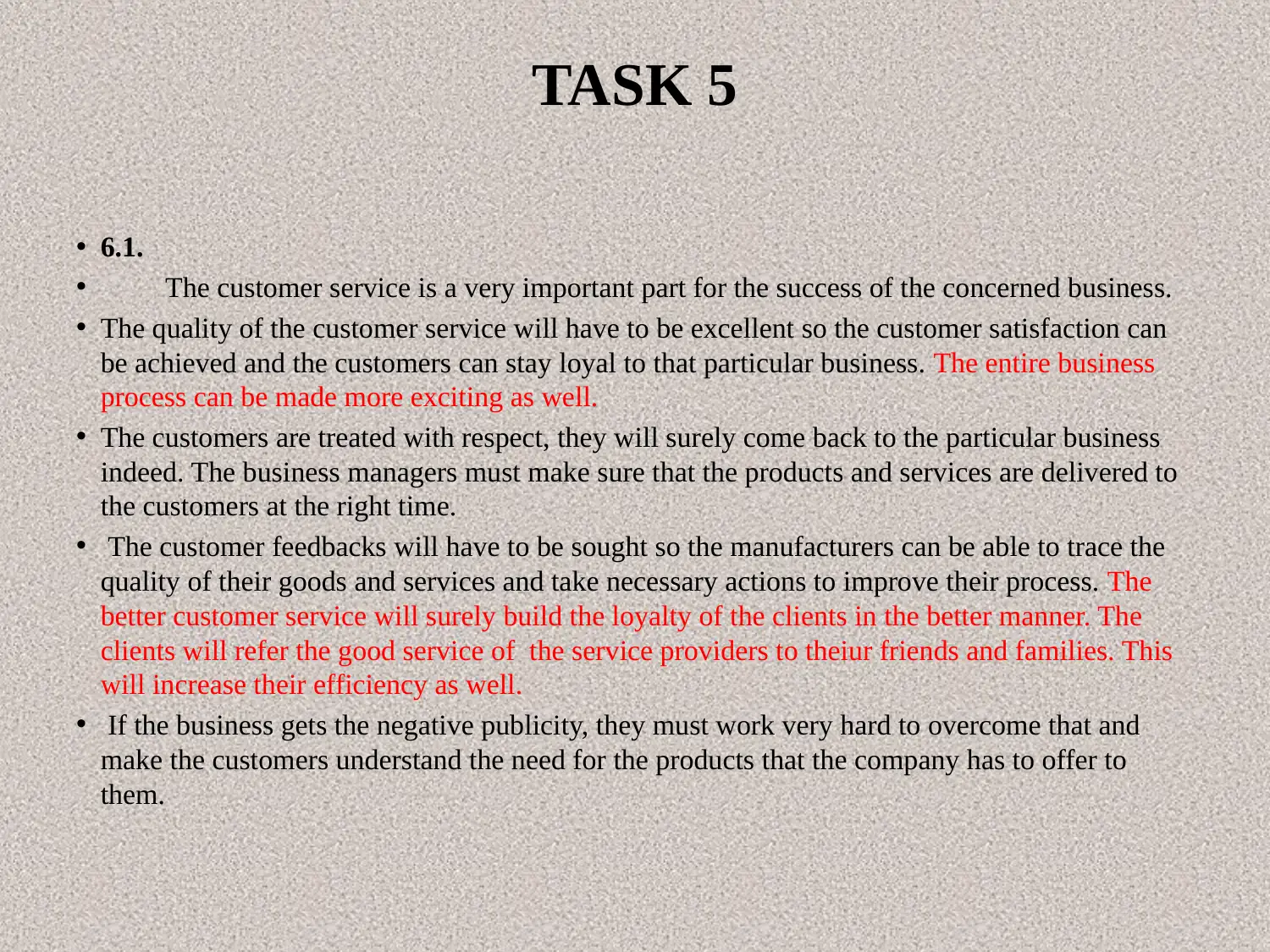
TASK 5
• 6.1.
• The customer service is a very important part for the success of the concerned business.
• The quality of the customer service will have to be excellent so the customer satisfaction can
be achieved and the customers can stay loyal to that particular business. The entire business
process can be made more exciting as well.
• The customers are treated with respect, they will surely come back to the particular business
indeed. The business managers must make sure that the products and services are delivered to
the customers at the right time.
• The customer feedbacks will have to be sought so the manufacturers can be able to trace the
quality of their goods and services and take necessary actions to improve their process. The
better customer service will surely build the loyalty of the clients in the better manner. The
clients will refer the good service of the service providers to theiur friends and families. This
will increase their efficiency as well.
• If the business gets the negative publicity, they must work very hard to overcome that and
make the customers understand the need for the products that the company has to offer to
them.
• 6.1.
• The customer service is a very important part for the success of the concerned business.
• The quality of the customer service will have to be excellent so the customer satisfaction can
be achieved and the customers can stay loyal to that particular business. The entire business
process can be made more exciting as well.
• The customers are treated with respect, they will surely come back to the particular business
indeed. The business managers must make sure that the products and services are delivered to
the customers at the right time.
• The customer feedbacks will have to be sought so the manufacturers can be able to trace the
quality of their goods and services and take necessary actions to improve their process. The
better customer service will surely build the loyalty of the clients in the better manner. The
clients will refer the good service of the service providers to theiur friends and families. This
will increase their efficiency as well.
• If the business gets the negative publicity, they must work very hard to overcome that and
make the customers understand the need for the products that the company has to offer to
them.
⊘ This is a preview!⊘
Do you want full access?
Subscribe today to unlock all pages.

Trusted by 1+ million students worldwide
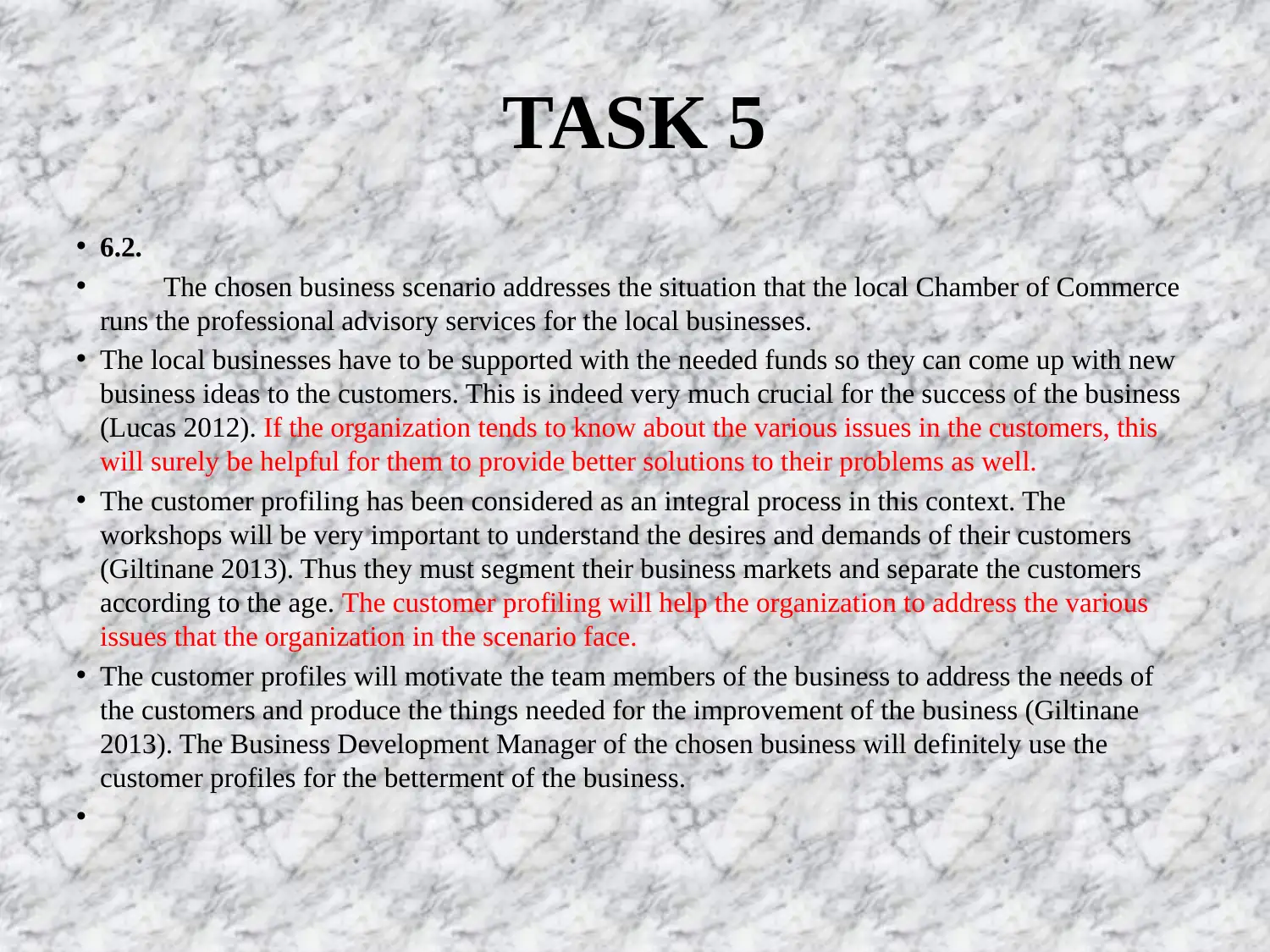
TASK 5
• 6.2.
• The chosen business scenario addresses the situation that the local Chamber of Commerce
runs the professional advisory services for the local businesses.
• The local businesses have to be supported with the needed funds so they can come up with new
business ideas to the customers. This is indeed very much crucial for the success of the business
(Lucas 2012). If the organization tends to know about the various issues in the customers, this
will surely be helpful for them to provide better solutions to their problems as well.
• The customer profiling has been considered as an integral process in this context. The
workshops will be very important to understand the desires and demands of their customers
(Giltinane 2013). Thus they must segment their business markets and separate the customers
according to the age. The customer profiling will help the organization to address the various
issues that the organization in the scenario face.
• The customer profiles will motivate the team members of the business to address the needs of
the customers and produce the things needed for the improvement of the business (Giltinane
2013). The Business Development Manager of the chosen business will definitely use the
customer profiles for the betterment of the business.
•
• 6.2.
• The chosen business scenario addresses the situation that the local Chamber of Commerce
runs the professional advisory services for the local businesses.
• The local businesses have to be supported with the needed funds so they can come up with new
business ideas to the customers. This is indeed very much crucial for the success of the business
(Lucas 2012). If the organization tends to know about the various issues in the customers, this
will surely be helpful for them to provide better solutions to their problems as well.
• The customer profiling has been considered as an integral process in this context. The
workshops will be very important to understand the desires and demands of their customers
(Giltinane 2013). Thus they must segment their business markets and separate the customers
according to the age. The customer profiling will help the organization to address the various
issues that the organization in the scenario face.
• The customer profiles will motivate the team members of the business to address the needs of
the customers and produce the things needed for the improvement of the business (Giltinane
2013). The Business Development Manager of the chosen business will definitely use the
customer profiles for the betterment of the business.
•
Paraphrase This Document
Need a fresh take? Get an instant paraphrase of this document with our AI Paraphraser
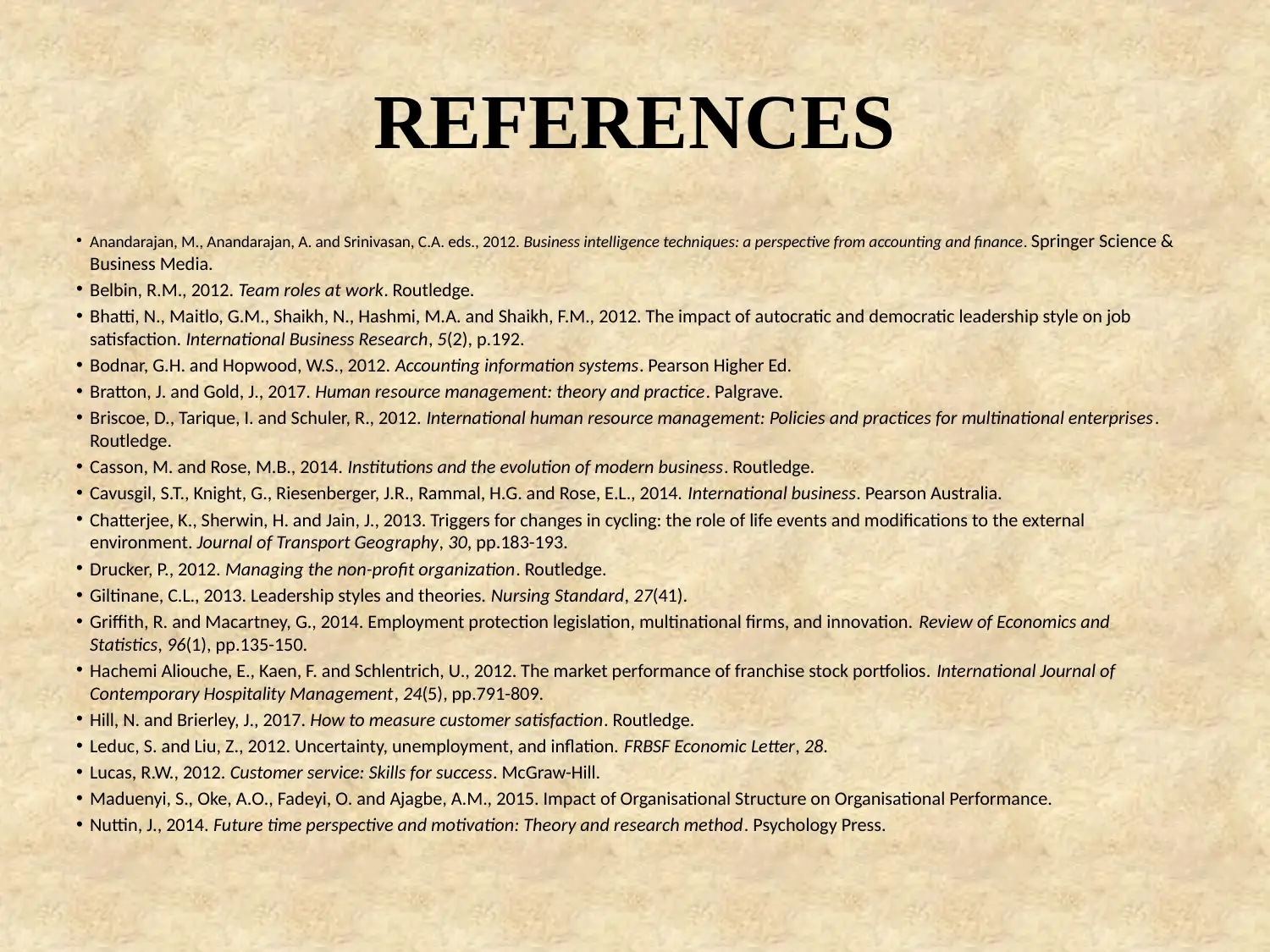
REFERENCES
• Anandarajan, M., Anandarajan, A. and Srinivasan, C.A. eds., 2012. Business intelligence techniques: a perspective from accounting and finance. Springer Science &
Business Media.
• Belbin, R.M., 2012. Team roles at work. Routledge.
• Bhatti, N., Maitlo, G.M., Shaikh, N., Hashmi, M.A. and Shaikh, F.M., 2012. The impact of autocratic and democratic leadership style on job
satisfaction. International Business Research, 5(2), p.192.
• Bodnar, G.H. and Hopwood, W.S., 2012. Accounting information systems. Pearson Higher Ed.
• Bratton, J. and Gold, J., 2017. Human resource management: theory and practice. Palgrave.
• Briscoe, D., Tarique, I. and Schuler, R., 2012. International human resource management: Policies and practices for multinational enterprises.
Routledge.
• Casson, M. and Rose, M.B., 2014. Institutions and the evolution of modern business. Routledge.
• Cavusgil, S.T., Knight, G., Riesenberger, J.R., Rammal, H.G. and Rose, E.L., 2014. International business. Pearson Australia.
• Chatterjee, K., Sherwin, H. and Jain, J., 2013. Triggers for changes in cycling: the role of life events and modifications to the external
environment. Journal of Transport Geography, 30, pp.183-193.
• Drucker, P., 2012. Managing the non-profit organization. Routledge.
• Giltinane, C.L., 2013. Leadership styles and theories. Nursing Standard, 27(41).
• Griffith, R. and Macartney, G., 2014. Employment protection legislation, multinational firms, and innovation. Review of Economics and
Statistics, 96(1), pp.135-150.
• Hachemi Aliouche, E., Kaen, F. and Schlentrich, U., 2012. The market performance of franchise stock portfolios. International Journal of
Contemporary Hospitality Management, 24(5), pp.791-809.
• Hill, N. and Brierley, J., 2017. How to measure customer satisfaction. Routledge.
• Leduc, S. and Liu, Z., 2012. Uncertainty, unemployment, and inflation. FRBSF Economic Letter, 28.
• Lucas, R.W., 2012. Customer service: Skills for success. McGraw-Hill.
• Maduenyi, S., Oke, A.O., Fadeyi, O. and Ajagbe, A.M., 2015. Impact of Organisational Structure on Organisational Performance.
• Nuttin, J., 2014. Future time perspective and motivation: Theory and research method. Psychology Press.
• Anandarajan, M., Anandarajan, A. and Srinivasan, C.A. eds., 2012. Business intelligence techniques: a perspective from accounting and finance. Springer Science &
Business Media.
• Belbin, R.M., 2012. Team roles at work. Routledge.
• Bhatti, N., Maitlo, G.M., Shaikh, N., Hashmi, M.A. and Shaikh, F.M., 2012. The impact of autocratic and democratic leadership style on job
satisfaction. International Business Research, 5(2), p.192.
• Bodnar, G.H. and Hopwood, W.S., 2012. Accounting information systems. Pearson Higher Ed.
• Bratton, J. and Gold, J., 2017. Human resource management: theory and practice. Palgrave.
• Briscoe, D., Tarique, I. and Schuler, R., 2012. International human resource management: Policies and practices for multinational enterprises.
Routledge.
• Casson, M. and Rose, M.B., 2014. Institutions and the evolution of modern business. Routledge.
• Cavusgil, S.T., Knight, G., Riesenberger, J.R., Rammal, H.G. and Rose, E.L., 2014. International business. Pearson Australia.
• Chatterjee, K., Sherwin, H. and Jain, J., 2013. Triggers for changes in cycling: the role of life events and modifications to the external
environment. Journal of Transport Geography, 30, pp.183-193.
• Drucker, P., 2012. Managing the non-profit organization. Routledge.
• Giltinane, C.L., 2013. Leadership styles and theories. Nursing Standard, 27(41).
• Griffith, R. and Macartney, G., 2014. Employment protection legislation, multinational firms, and innovation. Review of Economics and
Statistics, 96(1), pp.135-150.
• Hachemi Aliouche, E., Kaen, F. and Schlentrich, U., 2012. The market performance of franchise stock portfolios. International Journal of
Contemporary Hospitality Management, 24(5), pp.791-809.
• Hill, N. and Brierley, J., 2017. How to measure customer satisfaction. Routledge.
• Leduc, S. and Liu, Z., 2012. Uncertainty, unemployment, and inflation. FRBSF Economic Letter, 28.
• Lucas, R.W., 2012. Customer service: Skills for success. McGraw-Hill.
• Maduenyi, S., Oke, A.O., Fadeyi, O. and Ajagbe, A.M., 2015. Impact of Organisational Structure on Organisational Performance.
• Nuttin, J., 2014. Future time perspective and motivation: Theory and research method. Psychology Press.

⊘ This is a preview!⊘
Do you want full access?
Subscribe today to unlock all pages.

Trusted by 1+ million students worldwide
1 out of 9
Related Documents
Your All-in-One AI-Powered Toolkit for Academic Success.
+13062052269
info@desklib.com
Available 24*7 on WhatsApp / Email
![[object Object]](/_next/static/media/star-bottom.7253800d.svg)
Unlock your academic potential
Copyright © 2020–2025 A2Z Services. All Rights Reserved. Developed and managed by ZUCOL.





